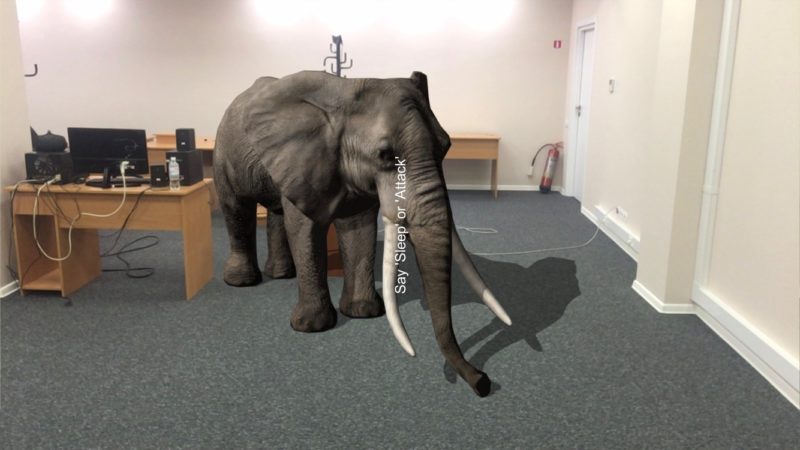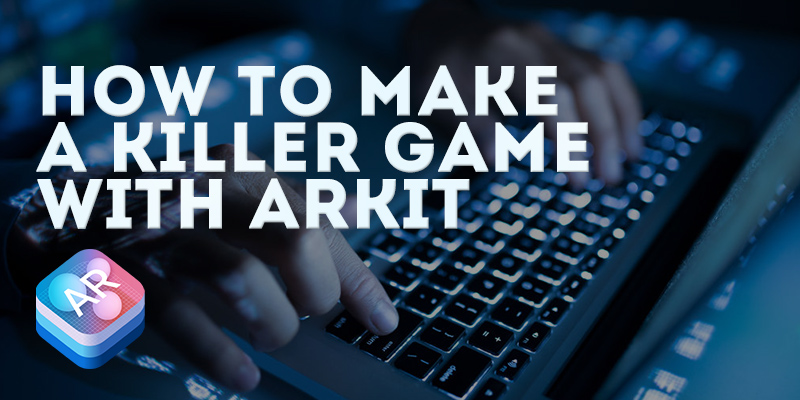The Internet is bustling with examples of how to build augmented reality games using ARKit, from instructions on using Xcode 9 with ARKit to providing complete sample code. With online resources becoming increasingly available to help game creators tap the power of ARKit, there is no excuse for not churning out the next generation of AR games today.
But building a really cool AR game with ARKkit should not be your sole focus for AR game development. Getting your piece of a $284.93 billion market should interest you, too. Capturing your share, however, will take more than powerful AR code. It will also require new levels of creativity to dazzle seasoned gamers.
In this article, we will avoid the coding aspects of Apple’s new AR development platform. Instead, we show you how the rich feature set in ARKit can enable you to create gameplay features that blow gamers’ minds — which is, after all, the recipe for any best-selling game.
Step Up Your Game with Powerful ARKit Features
Used in conjunction with iPhone X, ARKit brings an array of new features to augmented reality game development. We can summarize ARKit’s advanced feature set into the three capabilities shown below:
- Positional Tracking — Detects object position, orientation, and motion within the environment.
- Scene Understanding — Detects horizontal planes, tracks stable anchor points, and detects ambient lighting conditions.
- Rendering Integration — Allows integration with scene-rendering frameworks such as Metal, SceneKit, and SpriteKit.
How these features translate into your next AR game can be best understood if we break them down into the technologies that power them.
We should point out that some of the following capabilities are available only on the iPhone X.
TrueDepth Camera
Perhaps, one of the most exciting aspects of ARKit is its ability to make magic from the advanced iPhone X cameras. The pseudo-3D depth-sensing cameras and supporting ARKit technology allow you to integrate the following face-tracking features into your AR game:
- Detection of 50+ muscle movements.
- Custom rendering of graphics over 3D face mesh models.
- Position and orientation detection in real time (updated 60 times per second).
- Lighting estimation based on the face illumination.
- Facial recognition.
TrueDepth Camera Technology in AR Games
That’s all well and good, but what does this mean for your next game? Here are a few possibilities to get your wheels spinning.
- The game player can be transformed into virtual characters in real time, complete with accurate facial expressions.
- Scene realism can be greatly enhanced through light estimation, which can be applied to each individual virtual object as it is rendered, and as it changes position.
- The power of facial recognition allows you to render the proper character based solely on who is within the camera view.
- Accurate depth-sensing, combined with high-resolution 3D position detection, means that you can transform any environment into a 3D augmented reality gamescape. As you will see from our Dino demo, shown below, the physical barriers of walls and ceilings disappear.
This list represents but a scant few examples of what TrueDepth camera technology can mean for your games.

ARKit demo game by AppReal —
How to develop ARKit games
Visual Inertial Odometry
In the most basic terms, VIO keeps your game informed of the precise position and orientation of the device in 3D space. ARKit will enable your game to associate the device position, orientation, and movement into corresponding changes within the virtual environment of the game. Here are some of the features it provides:
- ARKit enables a game to identify specific features within the real-world scene.
- Precise measurements of objects within the scene.
- Object movement is detected from frame to frame.
- Accurate 3D scene-modeling capabilities.
Visual Inertial Odometry in AR Games
These features lend themselves to a plethora of gaming possibilities.
- Imagine game weapons that automatically resize and adjust based on the size of the room.
- 3D models of the environment can be constructed during the game, for 360-degree gameplay.
- Game characters can be programmed to go after whoever or whatever moves within the camera frame.
With VIO, you now have the ability to let your game “learn” the entire room through 3D modeling. The result can be AR games where the player is challenged to defend themselves from attacks from any and all directions.
Scene Understanding and Lighting Estimation
Scene Understanding enables a game to intelligently assess the real-world scene, and to adjust game action or rendering characteristics accordingly.
The value of proper lighting in everyday work and play is undeniable. But we have come to expect AR objects to just not quite look right, as they cannot adjust to the lighting conditions of the room. That is, not until now.
Here are some of the features that ARKit brings to the table, and which provide for these very powerful gameplay functions:
- Horizontal plane detection and sizing.
- Tracking of objects virtually situated within the real-world environment.
- Ambient light estimation to render virtual objects in stunning realism.
Scene Understanding and Light Estimation in AR Games
ARKit enables development of AR games that understand the scene, and that adjust the illumination of virtual objects based on ambient lighting. Here are a few ways you can use the features in your games:
- Plane detection and size detection allows your game to place virtual objects within the real-world scene. It also keeps virtual objects positioned at the desired location, regardless of the position or orientation of the device.
- You can have a combination of stationary and non-stationary objects within the same frame.
- Natural lighting and shadows can be used to add nearly photorealistic detail to your game.
Game enjoyment is directly related to the visual realism of the game. ARKit enables you to create games that force virtual objects to conform to the 3D rules of the real world, and which render light and shadow in picture-perfect realism.
High Performance Hardware and Rendering Optimizations
Lastly, ARKit is designed to take advantage of advances in processors, the iOS 11 operating system, Metal, SceneKit, SpriteKit, and 3rd-party rendering tools, such as Unity and Unreal Engine.
Here is a brief list of the advantages of integrating ARKit with other technologies:
- Processors that are compatible with ARKit enable super-fast rendering of high-quality games. Gone are the days of gameplay ruined by hardware that was never designed to play games.
- Metal is a graphics framework that you can use along with ARKit to give your game a high level of control over the device Graphics Processing Unit (GPU).
- SceneKit is an advanced 3D graphics engine that is used to create realistic 3D animations.
- SpriteKit is similar to SceneKit, but is limited to 2D animations. ARKit can integrate technologies from both SpriteKit and SceneKit into a never-before-scene game experience.
- Unity and Unreal Engine are game engine platforms that enable you to develop and deploy high-quality 2D and 3D games.
High Performance Hardware and Rendering Optimizations in AR Games
The advanced hardware capabilities of Apple’s latest processors and iPhones provides opportunity for game developers to reach for the skies. No longer must game graphics look like, well, game graphics. Thanks to ARKit’s integration with Apple’s latest hardware, games can look as good as real life — maybe better.
ARKit integrates with leading game creation and graphics optimization programs. While you can create a decent game using only ARKit, if you want a best-seller, you will certainly tie in other platforms, as well. Using these tools allows you to create an endless variety of game characters, virtual landscapes, and other objects.
In light of the endless possibilities ARKit integration offers you for game development, any attempt to list them is futile. Even so, perhaps the following descriptions of now ARKit capabilities can be fully utilized through hardware and software may inspire you to reach for the skies with your next program.
- In the past, game designs were often constricted to meet hardware limitations. Thanks to ARKit and Apple’s AR-ready hardware, the only limitation to how fast, exciting, and realistic your game can be is your own imagination.
- For game to sell, they must be thrilling. To be thrilling, they must be realistic. Stop thinking of game graphics as unrealistic, cartoonish versions of the real world, and integrate ARKit with the tools needed to make your games truly life-like.
Examples of Games Created Using ARKit
ARKit is an enormously powerful AR development platform. When combined with the technology of rendering frameworks, and when targeting the features of iPhone X, the possibilities become unspeakable. Even so, we have to admit that Apple’s mega-contribution to AR is still new. Until ARKit apps begin to display the full potential of the platform, even simple demos can hint at what is possible. We hope the following two examples will inspire you to go forth and do great things:
Dino AR App Demo AppReal
Dino is an augmented reality application for iPhone, and created by the AppReal ARKit app development team. Despite its apparent simplicity, the capabilities it reveals opens up a world of possibilities.
ARKit Pets Demo - Augmented Reality iPhone App by AppReal
The AppReal Pet Demo reflects what can be done with a very limited amount of code and in a short period of time.
How AppReal Can Help You
ARKit has made augmented reality game development easier than ever. That does not mean expertise are no longer needed to develop AR games with market appeal — because they are. In fact, to fully exploit the power of ARKit, along with 3rd-party platforms, you must possess expert-level knowledge of ARKit, game design methodologies, and mobile app technology.
If your business goals include entering the lucrative AR game market, you need more than an article on how to make ARKit games, you need a technology partner who knows how to develop world-class gaming applications. That would be AppReal. We are a leading provider of outsourced AR development. With six R&D labs across Europe, we are positioned to serve your development needs, regardless of your location.
Why not call us, today, for a no-cost consultation?
The game is on.

